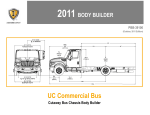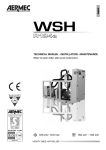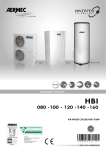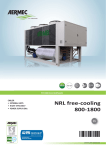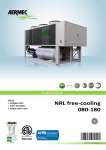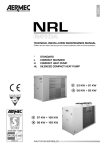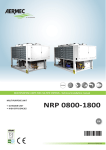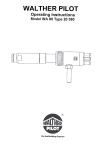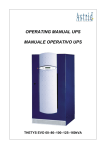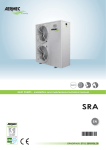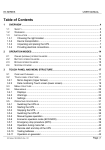Download Aermec NRL Free Cooling 2000
Transcript
CHILLERSS- Technical m manual anual - installation - maintenan maintenance NRL FREE-COOLING Multiscroll 2000-3600 EN INRLPY. 11.11 4086926_03 Dear Customer, Thank you for choosing AERMEC. It is the fruit of many years of experience and special design studies and has been made of the highest grade materials and with cutting edge technology. In addition, all our products bear the EC mark indicating that they meet the requirements of the European Machine Directive regarding safety. The standard of quality is permanently being monitored and AERMEC products are therefore a synonym for Safety, Quality and Reliability. The data may undergo modifications considered necessary for the improvement of the product, at any time and without the obligation for any notice thereof. Thank you again. AERMEC S.p.A AERMEC S.p.A. reserves the right at all times to make any modification for the improvement of its product and is not obliged to add these modification to machines of previous manufacture that have already been delivered or are being built. EN 4 CONTENT 16. SOUND DATA ........................................................................................... 21 1. 1.1. 1.2. GENERAL WARNINGS ................................................................................ 6 CONSERVING THE DOCUMENTATION ..................................................... 6 SAFETY PRECAUTIONS AND INSTALLATION ............................................. 6 17. CONTROL AND SAFETY PARAMETERS CALIBRATION ........................... 21 18. SELECTION AND PLACE OF INSTALLATION ........................................... 24 2. PRODUCT IDENTIFICATION ........................................................................ 6 19. 19.1. POSITIONING ............................................................................................ 24 MINIMUM TECHNICAL SPACES (mm) ..................................................... 24 3. 3.1. DESCRIPTION AND CHOICE OF THE UNIT................................................. 7 VERSIONS AVAILABLE ................................................................................ 7 4. CONFIGURATOR ........................................................................................ 8 5. 5.1. 5.2. 5.3. 5.4. CHILLER CIRCUIT ........................................................................................ 9 FRAME AND FANS ...................................................................................... 9 HYDRAULIC COMPONENTS ...................................................................... 9 SAFETY AND CONTROL COMPONENTS ................................................... 9 ELECTRICAL COMPONENTS ...................................................................... 9 20. 20.1. 20.2. 20.3. 20.4. 20.5. 20.6. 20.7. 6. ACCESSORIES ........................................................................................... 10 DIMENSIONAL TABLES ............................................................................. 25 MAXIMUM DIMENSIONS (ALL VERSIONS) ............................................. 25 HYDRAULIC CONNECTIONS - STANDARD (00) ...................................... 26 HYDRAULIC CONNECTIONS WITH PUMPS (P3-P4) ................................ 27 HYDRAULIC CONNECTIONS WITH STORAGE TANK AND PUMPS (03-04)28 POSIZION AVX AND PERCENTAGE WEIGHT DISTRIBUTION (NRL 2000) ... 29 POSIZION AVX AND PERCENTAGE WEIGHT DISTRIBUTION (NRL 2250) .. 30 POSIZION AVX AND PERCENTAGE WEIGHT DISTRIBUTION (NRL 2500 - 2800 - 3000) .......................................................................... 31 POSIZION AVX AND PERCENTAGE WEIGHT DISTRIBUTION (NRL 3300 - 3600) ..................................................................................... 32 7. 7.1. 7.2. 7.3. TECHNICAL DATA .................................................................................... 11 CHILLER FUNCTION TECHNICAL DATA ................................................... 11 FREE COOLING FUNCTION TECHNICAL DATA ...................................... 13 TECHNICAL DATA DESUPERHEATER........................................................ 14 21. 21.1. 21.2. 21.3. HYDRAULIC CIRCUIT ................................................................................ 33 EXTERNAL HYDRAULIC CIRCUIT RECOMMENDED................................. 33 SYSTEM LOAD .......................................................................................... 33 EMPTYING THE SYSTEM............................................................................. 33 8. 8.1. 8.2. OPERATING LIMITS ................................................................................... 15 COOLING MODE ..................................................................................... 15 DESIGN SPECIFICATIONS ......................................................................... 15 9. 9.1. 9.2. 9.3. CORRECTION FACTORS .......................................................................... 15 INPUT POWER AND COOLING CAPACITY "HIGH EFFICIENCY VERSION" ...15 FOR ∆T DIFFERENT FROM THE RATED VALUE .......................................... 16 FOULING FACTORS .................................................................................. 16 22. 22.1. 22.4. 22.2. 22.3. ELECTRICAL WIRINGS .............................................................................. 35 RECOMMENDED SECTION OF ELECTRIC CABLES ................................. 35 CONNECTION TO THE POWER SUPPLY................................................... 36 ELECTRICAL POWER CONNECTION ....................................................... 36 AUXILIARY CONNECTIONS AT THE USER/INSTALLER EXPENSE .............. 36 10. TOTAL PRESSURE DROPS ......................................................................... 16 23. 23.1. 23.2. 23.3. CONTROL AND FIRST START-UP ............................................................... 37 PREPARATION FOR COMMISSIONING ................................................... 37 FIRST COMMISSIONING OF THE MACHINE............................................. 37 SEASON CHANGEOVER .......................................................................... 37 11. USEFUL HEADS ......................................................................................... 17 12. 12.1. GLYCOL .................................................................................................... 18 HOW TO READ THE GLYCOL CURVES .................................................... 18 13. EXPANSION TANK CALIBRATION ............................................................ 19 24. 24.1. 24.2. 24.3. 24.4. 24.5. 24.6. FUNCTIONING CHARACTERISTICS .......................................................... 38 COOLING SET POINT................................................................................ 38 HEATING SET POINT .................................................................................. 38 COMPRESSOR START DELAY ................................................................... 38 CIRCULATION PUMP ................................................................................ 38 ANTI-FREEZE ALARM ................................................................................. 38 WATER FLOW RATE ALARM ..................................................................... 38 14. MINIMUM WATER CONTENT .................................................................... 19 25. REGULAR MAINTENANCE........................................................................ 38 15. 15.1. 15.2. DESUPERHEATER ....................................................................................... 20 PRESSURE DROPS ..................................................................................... 20 DESUPERHEATER PRESSURE DROP OF HYDRAULIC CIRCUIT 2 .............. 21 26. EXTRAORDINARY MAINTENANCE ........................................................... 38 INRLPY. 11.11 4086926_03 20.8. EN AERMEC S.p.A. 37040 Bevilacqua (VR) Italy – Via Roma, 996 Tel. (+39) 0442 633111 Telefax 0442 93730–(+39) 0442 93566 www . aermec . com - info @ aermec . com NRL FREE-COOLING SERIAL NUMBER CONFORMITY DECLARATION We, the undersigned, declare on our own exclusive responsibility that the object in question, so defined: NAME NRL FREECOOLING TYPE AIR - WATER CHILLER MODEL and to which this declaration refers, complies with the following standardised regulations: CEI EN 60335-2-40 Safety regulation regarding electric heat pumps, air conditioners and dehumidifiers CEI EN 61000-6-1 CEI EN 61000-6-3 Electromagnetic immunity and emission in residential environment CEI EN 61000-6-2 CEI EN 61000-6-4 Electromagnetic immunity and emission in industrial environment EN378 Refrigerating system and heat pumps - Safety and environmental requirements UNI EN 12735 UNI EN 14276 Round welding-free copper pipes for air conditioning and cooling Pressure equipment for refrigerating systems and heat pumps thus meeting the essential requisites of the following directives: - LV Directive: 2006/95/EC - Electromagnetic Compatibility Directive 2004/108/EC - Machine Directive 2006/42/EC - PED Directive relating to pressure equipment 97/23/EC In compliance with Directive 97/23/EC, the product meets the Total Quality Warranty procedure (module H) with certificate no. 06/270-QT3664 Rev.5 issued by the notified body no. 1131 CEC via Pisacane 46 Legnano (MI) - Italy The person authorized to compile the technical file is: Massimiliano Sfragara - 37040 Bevilacqua (VR) Italy–Via Roma, 996 Bevilacqua 28/12/2009 Marketing Director Signature INRLPY. 11.11 4086926_03 5 EN 1. GENERAL WARNINGS Standards and directives to be followed in the design and manufacture of the unit: Safety system: Machine Directive 2006/42/EC Low voltage directive LVD 2006/95/EC Electromagnetic compatibility directive EMC 2004/108/EC Pressure containers directive PED 97/23/CE EN 378, UNI EN 14276 Electrical part: EN 60204-1 Protection rating IP24 Acoustic part: SOUND POWER (EN ISO 9614-2) SOUND PRESSURE (EN ISO 3744) Refrigerant GAS: This unit contains fluorinated greenhouse gases covered by the Kyoto Protocol. Maintenance and disposal operations must be only carried out by qualified staff. R410A GWP=1900 The AERMEC NRL units are built according to the recognised standards and safety regulations. They have been designed for air conditioning and production of hot water and must be used for this purpose in accordance with their performance characteristics. The company shall not be contractually or non-contractually liable for any damage to people, animals or objects, for failures caused by errors during installation, adjustment and maintenance or incorrect use. All the uses not expressly indicated in this manual are not allowed. 1.1. 1.2. − − CONSERVING THE DOCUMENTATION Deliver the following instructions plus all the complementary documentation to the system user, who shall be responsible for keeping the instructions so that they are always available when needed. Read carefully this chapter; all the procedures must be carried out by qualified personnel according to the regulations in force in the different countries (M.D. 329/2004). It must be installed in such a way as to make all maintenance and/or repair operations possible (SEE INSTALLER SECTION page 25). The warranty of the device does not in any case cover costs owing to ladder trucks, lifts or other lifting systems that may be required in order to carry out the interventions under guarantee. Do not modify or tamper the with chiller as this may cause dangerous situations and the manufacturer shall not be liable for any damages. The warranty shall not be valid if the indications mentioned above are not observed. 2. SAFETY PRECAUTIONS AND INSTALLATION The chiller must be installed by an authorised and qualified technician, in compliance with the national legislation in force in the country of destination (MD 329/2004). Aermec shall not be held responsible for any damage whatsoever resulting from the non-compliance with these instructions. Before starting any kind of work, it is necessary TO READ CAREFULLY THE INSTRUCTIONS, AND TO PERFORM THE SAFETY CHECKS TO AVOID ANY RISKS. All the personnel in charge must know the operations and the risks that may arise when all the unit installation operations begin. PRODUCT IDENTIFICATION The NRL can be identified by the following: − − PACKING LABEL which shows the product identification data TECHNICAL PLATE Positioned on the right lateral sidemember (see fig.1) ATTENTION Tampering, removal and/or a missing identification plate does not allow safe identification of the product and will complicate any installation or maintenance operation. TECHNICAL PLATE POSITION TECHNICAL PLATE ATTENTION Drawings are only an example 6 INRLPY. 11.11 4086926_03 Fig.1 EN 3. DESCRIPTION AND CHOICE OF THE UNIT The NRL Free-cooling series appliances are water chillers equipped with an external air cooling capacity recovery system called "free-cooling". The water free-cooling system consists in integrating and eventually completely replacing the cooling capacity delivered by the compressors through an additional water coil that exploits the low temperature of the external air to cool the system's return water. Therefore, basically free chilled water can be obtained with this system for all installations where a continuos production is not required and therefore also with low external air temperatures; e.g. industrial processes, shopping centres, hospitals and other civil applications. Considerable energy saving can be achieved with this type of solution: when the return flow of the system is 2°C below the external air temperature, a three-way valve diverts the water into the free-cooling coil to be pre-cooled, after which it is sent to the evaporator where it is taken to the desired temperature. The NRL free-cooling units are comprised of two R410A refrigerating circuits and one water circuit that by means of a three-wayvalve can activate the free-cooling water coil positioned in series with the plate evaporator. The water circuit may or may not be supplied with an accumulator assembly. Thanks to several scroll type compressors and the fan speed control by means of the speed regulator, the NRL chillers can obtain various cooling capacity levels both in the compressors only mode as well as the free-cooling mode (partial or total). The electronic adjustment with optimised microprocessor for free-cooling controls and manages all the unit components and operating parameters; an internal memory registers the operating condition as soon as an alarm arises and subsequently displays it. The units have an IP 24 safety level. All appliances in the various versions are equipped as standard with: − fan speed control device, − evaporator antifreeze heating element, − compressor casing heater, − remote control panel, − water filter − flow switch OPERATING MODE: − FREE-COOLING ONLY: when the external temperature is sufficiently low to allow water cooling inside the free-cooling coils at the desired temperature. This is the most economical mode of the unit with only the fans operating in speed modulation. − MIXED FREE-COOLING + COMPRESSORS: the compressors operate in integration with the free-cooling when the cooling capacity recovered from the external air is no longer sufficient for the power required by the system. The higher the cooling capacity recovery with free-cooling the lower the integration is. − COMPRESSORS ONLY: when the external air temperature is greater than the return temperature of the system water. 3.1. − − − VERSIONS AVAILABLE “COOLING ONLY” (A - E) maximum permissible external temperature 46°C; processed water temperature 18°C; The units with desuperheater (D) are not available in the versions: YD XD (only for temperature lower than 4°C) Danger! The refrigerant circuit is under steam. High temperatures are also possible. The unit may only be opened by a service technician (SAT) or by an authorised technician. The operations in the cooling circuit can only be performed by a qualified refrigeration technician. GAS R410A The chiller is delivered with the correct refrigerant load. The R410A is free of chlorine, it is not flammable and does not harm the ozone layer. However, any interventions are always competence of the technical service assistance (SAT) or an authorised technician. INRLPY. 11.11 4086926_03 7 EN 4. CONFIGURATOR 1, 2, 3 4, 5, 6 7 8 9 10 11 12 13 14 15, 16 NRL 200 0 ° F ° A ° ° ° 00 field 1, 2, 3 Code NRL 4, 5, 6 Size 200, 225, 250, 280, 300, 330, 360 7 Compressors 0 Standard compressor 8 Thermostatic valve ° Standard mechanical thermostatic valve Y Mechanical thermostatic valve with produced water from +4°C to -6°C x Electronic thermostatic valve with produced water up to -6°C 9 Model F 10 11 12 13 14 15, 16 8 Free-cooling Heat recovery ° Without recovery units D Desuperheater Version A High efficiency E High efficiency, silenced version Coils ° R S V Made of aluminium Made of copper Tinned copper Painted aluminium (epoxy paint) Fans ° J Standard Inverter Fuel feed ° 2 400V-3-50Hz with thermomagnetic switches 500V-3-50Hz with thermomagnetic switches Accumulation 00 Without water storage 03 Water storage tank and high-head single pump 04 Water storage tank, with high-head pump and reserve pump P3 Without water storage tank, with high-head pump P4 Without water storage tank, with high-head pump and reserve pump INRLPY. 11.11 4086926_03 EN 5. CHILLER CIRCUIT Compressors High efficiency scroll-type hermetic compressors (assembled on elastic anti-vibration supports) driven by a 2-pole electric motor with internal thermal protection of the electric heater casing included as standard. The heater is automatically powered when the unit stops, provided that the unit is kept under tension. Air side heat exchanger High efficiency device made of copper pipes and aluminium blades locked into place via mechanical pipe expansion. Water side heat exchanger Of the plate-type (AISI 316), externally insulated with closed cell material to reduce thermal dispersion. Fitted, as standard, with antifreeze heater. Filter drier Of the mechanical cartridge type, made of ceramics and hygroscopic material able to trap impurities and any traces of humidity in the chiller circuit. Sight glass For checking the refrigerating gas load and any humidity in the refrigerating circuit. Thermostatic valve The mechanical type valve, with outside equaliser on the evaporator outlet, modulates the gas flow to the evaporator on the basis of the thermal load, in such a way as to ensure the proper degree of overheating of the intake gas. Taps Present in the liquid and discharge lines, and allow to intercept the refrigerant in case of extraordinary maintenance. Solenoid valve The valve closes when the compressor turns off, preventing the flow of refrigerant gas towards the evaporator. Desuperheater (optional) (2 per parallel circuit) Of the plate-type (AISI 316), externally insulated with closed cell material to reduce thermal dispersion. 5.1. 5.2. HYDRAULIC COMPONENTS Circulation pumps (versions with pump only or with accumulator) Depending on the characteristics of the pump chosen, it offers a useful head to overcome the pressure drops in the system. There is also the possibility to have a reserve pump. The reserve pump is managed by the electronic card. 3-way valve This is an electric servo-controlled ON-OFF diverting valve on the water side of the freecooling circuit controlled. Flow switch 1 per circuit (installed as standard) Controls that the water is circulating, otherwise the unit blocks. Water filter (installed as standard) Allows you to block and eliminate any impurities in the hydraulic circuits. Inside, it has a filtering mesh with holes not greater than one millimetre. It is essential for avoiding serious damage to the plate-type exchanger. Drain valve 1 per circuit (installato di serie) Of the automatic type, assembled on the upper part of the hydraulic system; it releases any air bubbles that may be present in the system. Storage tank In stainless steel, with a 700-litre capacity. In order to reduce the thermal dispersion and eliminate the phenomenon of the formation of condensation, it is insulated with polyurethane material of a suitable thickness. One antifreeze electric heater of 300W (down to -20°C outside temperature and tank water temperature 5°C) assembled as standard and commanded from the card via an antifreeze sensor inserted in the tank. Expansion tank 2 per circuit (2x25 Lt) Of the membrane type, with nitrogen precharge. Hydraulic circuit safety valve 1 per circuit Calibrated to 6 bar and with ductable discharge, it releases overpressure in the event of abnormal working pressure levels. 5.3. SAFETY AND CONTROL COMPONENTS FRAME AND FANS Fan unit Screw type, statically and dynamically balanced. The electric fans are protected electrically with thermomagnetic switches and mechanically with metal anti-intrusion grilles, in accordance with the standard CEI EN 60335-2-40. Load-bearing structure Made of hot-galvanised steel sheet of a suitable thickness, varnished with polyester powders able to resist atmospheric agents over time. High pressure switch (AP) (installed as standard) With fixed calibration, placed on the high pressure side of the chiller circuit, it shuts down compressor operation in the case of abnormal operating pressure. Low pressure transducer (BP) - (TP2) (installed as standard) Of fixed calibration, located on the low pressure side of the refrigerating circuit, it stops the operation of the compressor in the event of anomalous work pressures. High pressure transducer - (TP3) (installed as standard) Placed on the high pressure side of the chiller circuit, it communicates to the control card the operating pressure, sending a prealarm in case of abnormal pressure. Evaporator antifreeze heating element Its operation is commanded by the antifreeze probe located in the plate-type evaporator. It is activated when the water temperature is +3°C, and deactivated when the water temperature is +5°C. The dedicated software in the regulation card manages the heater. Refrigerating circuit safety valve This intervenes by releasing overpressure in the event of abnormal working pressure levels. - Calibrated at 45 bar on the HP branch 5.4. ELECTRICAL COMPONENTS ELECTRICAL PANEL Contains the power section and the management of the controls and safety devices. In accordance with standards: CEI EN 61000-6-1 CEI EN 61000-6-2 CEI EN 61000-6-4 (immunity and electromagnetic emissions for the industrial sector). and Directives EMC 89/336/EEC and 92/31/ EEC concerning electromagnetic compatibility, Low Voltage Directive LVD 2006/95/ EC. DOOR LOCK KNIFE SWITCH IT is possible to access the electrical panel by disconnecting the voltage, then using the opening lever of the panel itself. This lever can be blocked with one or more padlocks during maintenance, in order to prevent the machine being powered up accidentally. CONTROL KEYPAD Provides full control functions. For a detailed description refer to the user manual. Remote control panel (PR3) This allows the chiller command operations to be given from a distance. Compressor protection thermomagnetic switch; Fan protection thermomagnetic switch; Auxiliary protection thermomagnetic switch; Discharge gas temperature control thermostat. ELECTRONIC REGULATION MICROPROCESSOR CARD Consisting of a management/control card and a visualisation card. • Functions carried out: − adjustment of water temperature at evaporator inlet, with thermostat control for up to 4 levels and integralproportional fan speed control (with DCPX accessory); − compressor start-up delay; − compressor sequence rotation; INRLPY. 11.11 4086926_03 9 EN − − − − − − − count of compressor work hours; start/stop; reset; permanent alarms memory; autostart after voltage drop; multi-lingual messages; operation with local or remote control. • − − Machine status display: ON/OFF compressors; alarms summary. • − Alarm management: high pressure; 6. flow switch; low pressure; anti-freeze; compressor overload; fan overload; pump overload. • − − − − − − Display of the following parameters: water inlet temperature; accumulator temperature; water outlet temperature; delta T; high pressure; low pressure; − − waiting time for restart; alarms visualisation. • Settings: a) without password: cooling set; total differential. b) with password: antifreeze set; low pressure exclusion time; display language; access code. For further information, refer to the user manual. ACCESSORIES 200 AER485P1 A E • • AVX (00) A E AVX (03-04) AVX (P3-P4) 782 788 794 801 801 Sprung anti-vibration supports. Select the model using the compatibility table. 777 783 789 795 802 802 Sprung anti-vibration supports. Select the model using the compatibility table. 772 778 784 790 796 803 803 350x2 500x2 500x2 Protect the external coils from accidental knocks. GP A E 260x2 PGS A E • • AERWEB30 A E • • RIF RIFNRL2000 TRX1 A E • • PRM 1 A E • • PRM 2 A E 776 771 A E A E 225 250 280 300 330 360 Through this accessory it is possible to connect the unit with BMS supervision systems with electrical standard RS 485 and MODBUS type protocol. • • • • • • • • • • • • Sprung anti-vibration supports. Select the model using the compatibility table. 770 A E 10 − − − − − − - 260 350 350x2 350x2 Card to be inserted in the electronic card of the unit. Allows you to programme two time bands per day (two switch on/off cycles) and to have differentiated programming for each day of the week. • • • • • • • • • • • • AERWEB30: the AERWEB device allows the remote control of a chiller from a common PC, using a serial connection. Using additional modules, the device allows the chiller to be controlled via the telephone line, using the AERMODEM accessory, or via the GSM network, using the AERMODEM GSM accessory. AERWEB can pilot up to 9 chillers, but each of these must be equipped with accessory AER485 or AER485P2. • • • • • • • • • • • • Current rephaser. Parallel connection with the motor makes the reduction of input current possible. It can only be installed when the machine is being made and must therefore be specified when the order is placed. RIFNRL2250 RIFNRL2500 RIFNRL2800 RIFNRL3000 RIFNRL3300 RIFNRL3600 The water accumulators with holes and supplementary electric heaters leave the factory with plastic protection caps. Before loading the system, if the installation of an electric heater is not envisaged it is compulsory to replace the plastic caps with the special TRX1. • • • • • • • • • • • • FACTORY-ASSEMBLED ACCESSORY. Pressure switch with manual reset (using a tool), electrically connected in series to the high pressure switch on the compressor delivery pipe. FACTORY-ASSEMBLED ACCESSORY. Pressure switch with manual reset (using a tool), electrically connected in series to the high pressure switch on the compressor delivery pipe. • • • • • • • • • • • • INRLPY. 11.11 4086926_03 EN 7. TECHNICAL DATA 7.1. CHILLER FUNCTION TECHNICAL DATA COOLING Cooling output kW Total input power kW Water flow rate l/h Total pressure drops kPa A E A E A E A E 2000 494 456 206 218 84970 78430 81 69 2250 557 517 217 229 95800 88920 92 80 2500 620 578 228 240 106640 99420 92 80 2800 674 620 272 290 115930 106640 98 84 3000 728 662 314 338 125220 113860 83 70 3300 860 800 318 338 147920 137600 104 90 3600 904 842 350 372 155490 144820 107 93 A E 2.40 2.09 2.57 2.26 2.72 2.41 2.48 2.14 2.32 1.96 2.70 2.37 2.58 2.26 Energy indices EER W/W ELECTRICAL DATA Fuel feed A Input current A Maximum current A Peak current A A E A E A E A E 400V - 3 - 50 Hz 389 407 403 421 417 435 504 529 592 624 597 621 634 665 442 495 548 606 664 747 813 651 763 816 815 873 1015 1081 8/4 8/4 8/4 10/4 12/4 12/4 12/4 8 10 12 12 12 16 16 156000 111600 13.9 10.5 29.6 22.2 193200 136400 17.4 13.1 37 27.75 230400 161200 20.9 15.7 44.4 33.3 228000 159600 20.9 15.7 44.4 33.3 225600 161400 20.9 15.7 44.4 33.3 310400 217200 27.9 20.9 59.2 44.4 307200 219600 27.9 20.9 59.2 44.4 8 10 12 12 12 16 16 13.9 29.6 46 - 17.4 37 47 - 20.9 44.4 46 - 20.9 44.4 45 - 20.9 44.4 44 - 27.9 59.2 46 - 27.9 59.2 2 2 2 2 2 2 2 3" 3"/4”* 4" 4" 4" 4" 4" 204 - 242 - 242 - 223 - 224 - 192 - 182 - COMPRESSORS (SCROLL) Number/Circuit no./no. A E FANS (AXIAL) Quantity no. Air flow rate m³/h Input power kW Input current A A E A E A E A E INVERTER FANS Quantity no. Input power kW Input current A Available head [1] A A E A E A E A E 46 - EVAPORATORS (PLATES) Quantity Water connections (in/out) [*] Useful head no. diam kPa A E A E A E HYDRAULIC CIRCUIT Accumulator capacity No./l Accumulator antifreeze heater n°/W Expansion tank capacity No./l A E A E A E 2 x 700 2 x 300 4 x 25 [*] The water connections are all of the Victaulic type * For the 2250 version, 3" connectors are foreseen for the 1000 model and 4" for the 1250 model [1] The useful heads refer to the nominal air flow rate INRLPY. 11.11 4086926_03 11 EN 2000 2250 2500 2800 3000 3300 3600 13.0 6.5+8.6 17.2 17.2 17.2 24.7 24.7 22.0 11+14.6 29.2 29.2 29.2 42.4 42.4 204 223 242 262 242 262 223 250 224 255 192 214 182 206 91.5 85.5 59.5 53.5 93.5 87.5 61.5 55.5 94.5 88.5 62.5 56.5 94 88.0 62 56 93.5 87.5 61.5 55.5 95 89.0 63 57 97 91.0 65 59 2450 2450 2450 2450 2450 2450 2450 2200 2200 2200 2200 2200 2200 2200 6400 7250 8100 8100 8100 11100 11100 5670 6190 6700 7120 7580 9060 9330 HIGH-HEAD CIRCULATION PUMP Input power KW Input current A Useful head kPa A E A E A E SOUND DATA Sound power (1) dBA Sound pressure (2) dBA A E A E DIMENSIONS Height mm Width mm Depth mm Weight when empty kg A E A E A E A E NOMINAL REFERENCE CONDITIONS COOLING MODE - Inlet water temperature - Outlet water temperature - Outside air temperature - ∆t 12 INRLPY. 11.11 4086926_03 12°C 7°C 35°C 5°C (1) SOUND POWER Aermec determines the sound power value on the basis of measurements taken in accordance with standard 9614-2. (2) SOUND PRESSURE Sound pressure in an unrestricted range on a reflective plane (directional fact. Q=2), 10m away from the unit external surface, complying with ISO 3744. EN 7.2. FREE COOLING FUNCTION TECHNICAL DATA COOLING Cooling output kW Total input power kW Water flow rate l/h Total pressure drops kPa A E A E A E A E A E 2000 458 446 2250 486 486 2500 514 526 2800 582 576 3000 652 627 3300 798 792 3600 880 887 15 19 22 22 22 29 29 85115 78413 110 94 95903 88871 123 107 106691 99330 123 107 115871 106518 131 111 125052 113706 117 97 147870 137540 140 122 155459 144658 145 126 30.53 29.73 25.58 25.58 23.36 23.91 26.45 26.18 29.64 28.50 27.52 27.31 30.34 30.59 ENERGY INDICES EER W/W ELECTRICAL DATA Fuel feed A Input current A Maximum current A Peak current A A E A E A E A E 400V - 3 - 50 Hz 30 37 44 44 44 59 59 442 495 548 606 664 747 813 651 763 816 815 873 1015 1081 8/4 8/4 8/4 10/4 12/4 12/4 12/4 8 10 12 12 12 16 16 156000 111600 13.9 10.5 29.6 22.2 193200 136400 17.4 13.1 37 27.75 230400 161200 20.9 15.7 44.4 33.3 228000 159600 20.9 15.7 44.4 33.3 225600 161400 20.9 15.7 44.4 33.3 310400 217200 27.9 20.9 59.2 44.4 307200 219600 27.9 20.9 59.2 44.4 8 10 12 12 12 16 16 13.9 29.6 46 - 17.4 37 47 - 20.9 44.4 46 - 20.9 44.4 45 - 20.9 44.4 44 - 27.9 59.2 46 - 27.9 59.2 2 2 2 2 2 2 2 3" 3"/4” 4" 4" 4" 4" 4" COMPRESSORS (SCROLL) Number/Circuit no./ no. A E FANS (AXIAL) Quantity no. Air flow rate m³/h Input power kW Input current A A E A E A E A E INVERTER FANS Quantity no. Input power kW Input current A Available head [1] A A E A E A E A E 46 - EVAPORATORS (PLATES) Quantity Water connections (in/out) [*] no. diam A E A E HYDRAULIC CIRCUIT Accumulator capacity No./l Accumulator antifreeze heater n°/W Expansion tank capacity No./l A E A E A E 2 X 700 2 x 300 4 x 25 * The water connections are all of the Victaulic type * For the 2250 version, 3" connectors are foreseen for the 1000 model and 4" for the 1250 model [1] The useful heads refer to the nominal air flow rate INRLPY. 11.11 4086926_03 13 EN 2000 2250 2500 2800 3000 3300 3600 13.0 6.5+8.6 17.2 17.2 17.2 24.7 24.7 18.0 9+13.2 26.4 26.4 26.4 33.6 33.6 177 199 214 239 214 239 195 226 195 231 165 191 155 182 91.5 85.5 59.5 53.5 93.5 87.3 61.5 55.3 94.5 88.5 62.5 56.5 94 88.0 62 56.0 93.5 87.5 61.5 55.5 95 89.0 63 57.0 97 91.0 65 59.0 2450 2450 2450 2450 2450 2450 2450 2200 2200 2200 2200 2200 2200 2200 6400 7250 8100 8100 8100 11100 11100 5670 6190 6700 7120 7580 9060 9330 HIGH-HEAD CIRCULATION PUMP Input power KW Input current A Useful head kPa A E A E A E SOUND DATA Sound power (1) dBA Sound pressure (2) dBA A E A E DIMENSIONS Height mm Width mm Depth mm Weight when empty kg A E A E A E A E NOMINAL REFERENCE CONDITIONS FC COOLING MODE - Inlet water temperature - Outside air temperature - Nominal water flow rate - Compressors OFF 7.3. 15°C 2°C (2) SOUND PRESSURE Sound pressure in an unrestricted range on a reflective plane (directional fact. Q=2), 10m away from the unit external surface, complying with ISO 3744. Technical data Desuperheater DESUPERHEATER Total recovered heating capacity Water flow rate Pressure drop 14 (1) SOUND POWER Aermec determines the sound power value on the basis of measurements taken in accordance with standard 9614-2. INRLPY. 11.11 4086926_03 U.M. kW l/h kPa 2000 191 32800 29.1 2250 206 35470 2500 221 38140 38 2800 253 43600 48.2 3000 285 49040 59.7 3300 310 53360 70.6 3600 335 57680 82.3 EN 8. OPERATING LIMITS 8.1. The devices in their standard configurations are not suitable for installation in salty environments. For the operating limits, refer to diagram 6.1, valid for ∆t = 5°C. COOLING MODE 46 45 Outside air temperature d.b. °C 40 ATTENTION Contact our technical sales department if the unit needs to operated outside the operating limits Wind breaks should be implemented if the unit is installed in particularly windy areas, to prevent a malfunction of the DCPX 35 Operation with glycol 30 25 Standard operation 20 15 10 Operation with glycol and with DCPX accessory 5 0 -5 Operation with DCPX accessory -10 -15 -5 0 5 10 15 18 Processed water temperature °C 8.2. DESIGN SPECIFICATIONS COOLING U.M. Maximum allowable pressure Maximum allowable temperature Minimum allowable temperature bar °C °C 9. CORRECTION FACTORS 9.1. INPUT POWER AND COOLING CAPACITY "HIGH EFFICIENCY VERSION" Side Side High pressure 42 120 -16 Low pressure 25 52 -16 Ca: ATTENTION FOR ∆t DIFFERENT FROM 5°C Tab. 9.2.1. is used for the correction factors of the cooling capacity and input power of the water consumption. To take into account the soiling of the exchanger, apply the relative fouling factors, Tab. 9.3.1. 30°C 35°C Outside air temperature °C 1,3 1,2 1,1 40°C 1 0,9 44°C 0,8 0,7 0,6 0,5 0,4 -4 -2 0 2 4 6 8 10 12 14 16 18 Processed water temperature (°C) correction coefficient of the cooling capacity. correction coefficient of the input power. 25°C 1,4 -6 CORRECTION COEFFICIENTS OF THE INPUT POWER IN COOLING MODE 1,4 Correction coefficients of the input power Ca KEY Cf: 20°C 1,5 1,3 44°C 1,2 40°C 35°C 30°C 1,1 25°C 1 20°C 0,9 0,8 Outside air temperature °C The refrigerating capacity yielded and the input electrical capacity in conditions other than rated conditions are obtained by multiplying the rated values (Pf, Pa) by the respective correction coefficients (Cf, Ca). The following diagrams allow you to obtain the correction coefficients to be used for the various versions of the devices, in cold mode; next to each curve you can see the outside air temperature to which it refers. Correction coefficients of the cooling capacity Cf CORRECTION COEFFICIENTS OF THE COOLING CAPACITY 1,6 0,7 0,6 -6 -4 -2 0 2 4 6 8 10 12 14 16 18 Processed water temperature (°C) INRLPY. 11.11 4086926_03 15 EN 9.2. FOR ∆t DIFFERENT FROM THE RATED VALUE 9.2.1. ∆t different from the rated value ∆t different from the rated value Cooling capacity correction factors Cooling capacity correction factors The performances given by the technical data refer to ∆t 5°C. Use table 7.2.1 to obtain the corrective factors of the cooling capacity and input power different than ∆t 5°C. 9.3. FOULING FACTORS Fouling factor [K*m2]/[W] Cooling capacity correction factors Cooling capacity correction factors The pressure drops include: 300 The diagram pressure drops are related to an average water temperature of 10 °C. The following table shows the correction to apply to the pressure drops when the average water temperature varies Pressure drops (kPa) 350 EVAPORATORS WATER FILTERS HYDRAULIC CIRCUITS 10 1.03 1.02 0.00005 1 1 0.0001 0.98 0.98 0.0002 094 0.95 3300 250 2250 2500 3000 2000 200 3600 2800 150 100 50 The chiller comprises two hydraulic circuits The pressure drops indicated in the graphics are relative to a single circuit SINCE THE HYDRAULIC PARALLEL IS IN CHARGE OF THE CUSTOMER OR THE OR THE PERSON IN CHARGE. 0 0 20000 40000 60000 80000 100000 120000 140000 160000 180000 200000 220000 240000 260000 280000 300000 Water flow rate l/h Free-cooling function pressure drop 400 3300 350 2250 300 2500 3600 2800 3000 2000 Pressure drops (kPa) ATTENTION The water outlet probe (WOP) with its trap is free, near the electrical box, remember to insert it in the collector of the outlet hydraulic parallel, using a sleeve of ½ inch. 8 1.02 1.01 Chiller function pressure drop TOTAL PRESSURE DROPS − − − 5 1 1 9.3.1. Fouling factor [K*m2]/[W] The performance levels given by the technical data refer to conditions with clean tubes, with a fouling factor = 1. For other fouling factor values, multiply the data of performance table 7.3.1. by the coefficients given. 10. 3 0.99 0.99 250 200 150 100 50 0 0 20000 40000 60000 80000 100000 120000 140000 160000 180000 200000 220000 240000 260000 280000 300000 Water flow rate l/h Average water temperature [°C] Multiplicational coefficient 16 INRLPY. 11.11 4086926_03 5 1.02 10 1 15 0.985 20 0.97 30 0.95 40 0.93 50 0.91 EN 11. USEFUL HEADS NRL chiller function useful head 400 Pressure drops (kPa) 350 300 250 200 3600 3300 150 100 Water flow rate [l/h] 20 50 0 40000 00 60000 80000 100000 120000 22 50 140000 25 00 300 0 00 28 160000 180000 200000 NRL free-cooling function useful heads 400 350 Pressure drops (kPa) 300 Water flow rate [l/h] 250 200 150 360 0 3300 100 20 50 0 40000 00 60000 80000 100000 120000 22 50 25 140000 00 28 00 160000 30 00 180000 200000 INRLPY. 11.11 4086926_03 17 EN GLYCOL − 12.1. HOW TO READ THE GLYCOL CURVES The curves shown in the figure summarise a notable quantity of data, each of which is represented by a specific curve. In order to use these curves correctly, it is necessary to make some initial considerations: − If you want to calculate the percentage of glycol on the basis of the outside air temperature, you must enter from the left-hand axis and, once you have intersected the curve, trace a vertical line which, in turn, will intercept all the other curves; the points obtained from the upper curves represent the coefficients for the correction of the cooling capacity and input power, for the flow rates and the pressure drops (remember that these coefficients must anyway be multiplied by the nominal value of the sizes examined); the lower axis advises the percentage of glycol necessary on the basis of the outside air temperature considered. − If you want to calculate the percentage of glycol on the basis of 18 INRLPY. 11.11 4086926_03 2.20 FcGDpF (a) 2.10 FcGDpF (b) 2.00 FcGDpF (c) 1.90 FcGDpF (d) 1.80 1.70 1.60 FcGDpF (e) 1.50 1.390 1.40 1.30 1.310 1.20 1.180 1.10 1.00 1.090 FcGQF 1.280 FcGQ (PdC) 1.110 FcGPf (PdC) 1.000 0.99 0.990 0.98 FcGPa 0.975 0.97 0.96 0.95 FcGPf 0.94 5 0 5 -5 -10 -6 0 -3 -15 -20 -25 Outside air temperature The cooling capacity and input power correction factors make allowance for the presence of glycol and the different evaporation temperature. − The pressure drop correction factor already takes account of the different flow rate deriving from the application of the water flow rate correction factor. − The correction factor of the water flow rate is calculated so as to maintain the same ∆t that would be used in the absence of glycol. NOTE To make it easier to read the following graph, an example is given. By using the diagram below it possible to establish the percentage of glycol necessary; this percentage can be calculated taking into account one of the following factors: On the basis of the fluid considered (water or air), it will be necessary to enter the graph from the right or left side, from the intersection of the outside air temperature or processed water temperature straight lines and the relative curves, a point is obtained through which the vertical line that will identify both the percentage of glycol and the relative correction coefficients will have to pass. -30 -35 -40 0 KEY: FcGPf FcGPa FcGDpF (a) FcGDpF (b) FcGDpF (c) FcGDpF (d) FcGDpF (e) FcGQF FcGQC 5 10 15 20 25 30 35 40 45 50 55 % Glycol Processed water temperature 12. Correction factor of the cooling capacity Correction factor of the input power Correction factor of the pressure drops (evaporator) (average temp. = -3.5°C) Correction factor of the pressure drops (average temp. = 0.5°C) Correction factor of the pressure drops (average temp. = 5.5°C) Correction factor of the pressure drops (average temp. = 9.5°C) Correction factor of the pressure drops (average temp. = 47.5°C) Correction factor of the outputs (evaporator) (average temp. = 9.5°C) Correction factor of the outputs (condenser) (average temp. = 47.5°C) NB: Although the graph reaches outside air temperatures of -40°C, it is necessary to maintain the machine's operating limits as reference. the temperature of the processed water, you must enter from the right-hand axis and, once you have intersected the curve, trace a vertical line which, in turn, will intercept all the other curves; the points obtained from the upper curves represent the coefficients for the cooling capacity and input power, for the flow rates and the pressure drops (remember that these coefficients must anyway be multiplied by the nominal value of the sizes examined); the lower axis advises the percentage of glycol necessary to produce water at the required temperature. − REMEMBER THAT THE INITIAL SIZES “Outside air temperature” AND “Processed water temperature”, are not directly linked to each other, so it is not possible to enter the curve of one of these sizes, and obtain the corresponding point on the other curve. EN 13. EXPANSION TANK CALIBRATION The standard pressure value for precharging the expansion tank is 1.5 bar, and the volume is 25 litres. Maximum value 6 bar. The tank must be calibrated according to the maximum difference in height (H) of the device (see figure) according to the formula: p (calibration) [bar] = H [m] / 10.2 + 0.3. For example, if the level difference H is 20m, the calibration value of the tank will be 2.3 bar. If the calibration value obtained from the calculation is lower than 1.5 bar (i.e. for H < 12.25), maintain the standard calibration. Ptar = H / 10.2 + 0.3 H max (1) = 55 m H = 12.25 m Ptar = 1.5 bar H Ptar = 1.5 bar H=0m H min (2) Key: [1] Check that the highest user does not exceed a level difference of 55 metres. [2] Check that the lowest user can sustain the global pressure acting at that point Hydraulic height Expansion tank calibration Water content reference value Water content reference value Water content reference value Hm bar l (1) l (2) l (3) 30 3.2 2.174 978 510 25 2.8 2.646 1190 622 20 2.3 3.118 1404 732 15 1.8 3590 1616 844 ≥ 12.25 1.5 3852 1732 904 Working reference conditions: (1) Cooling: Max. water temp. = 40°C, Min. water temp. = 4°C. (2) Heating (heat pump): Max. water temp. = 60°C, Min. water temp. = 4°C. (3) Heating (boiler): Max. water temp. = 85°C, Min. water temp. = 4°C. 14. MINIMUM WATER CONTENT NRL Compressor - quantity Minimum water content U.M. VERS. n° l/kW(1) l/kW(2) All 2000 2250 2500 2800 10 4 8 3000 3300 12 3600 INRLPY. 11.11 4086926_03 19 EN 15. DESUPERHEATER 15.1. The heating capacity that can be obtained from the desuperheater is obtained by multiplying the nominal value (Pd) shown in table 11.1.1 by a suitable coefficient (Cd). The diagrams will give you the correction coefficients to be used for the chillers in the various versions; next to each curve you can see the outside air temperature to which it refers. PRESSURE DROPS The NRL has 2 parallel desuperheaters, for circuits without filters. N.B.: the characteristics of the desuperheaters and the pressure drop curves are shown below. For processed water temperatures different from 50°C, the result obtained is multiplied by the correction factor that can be obtained from Table 11.1.1. The nominal value refers to: air temperature .................................... 35°C water at the desuperheater ........... 45/50°C ∆t ............................................................... 5°C DESUPERHEATER CORRECTION COEFFICIENTS 3.00 Cd correction coefficient 2.50 2.00 1.50 1.00 45°C 40°C 0.50 35°C 30°C 20°C 25°C 0.00 35 40 45 50 55 Processed water temperature at the desuperheater (∆t 5°C) 15.1.1. Corrective factors for water temperatures different than the nominal water temperature Average water temperature °C Multiplication coefficient 20 INRLPY. 11.11 4086926_03 30 1.04 40 1.02 50 1 60 0.98 70 0.96 60 65 EN 15.2. DESUPERHEATER PRESSURE DROP OF HYDRAULIC CIRCUIT 2 100 3300 - 3600 90 Pressure drops (kPa) 80 2800 - 3000 70 60 50 40 2000 - 2250 2500 30 20 10 0 0 20.000 40.000 60.000 80.000 100.000 120.000 Water flow rate l/h 16. SOUND DATA NRL FC Sound power Aermec determines the sound power value on the basis of measurements taken in accordance with standard 9614-2. Sound pressure Sound pressure in free field, on a reflecting plane (directional factor Q=2), in accordance with standard ISO 3744. NRL2000A NRL2250A NRL2500A NRL2800A NRL3000A NRL3300A NRL3600A Total sound levels Pressure Pow. dB(A) dB(A) dB(A) 10m 1m 92.0 60.0 74.0 93.0 61.0 75.0 94.5 62.5 76.5 94.0 62.0 76.0 93.5 61.5 75.5 95.0 63.0 77.0 97.0 65.0 79.0 125 250 Octave band[Hz] 500 1000 2000 4000 8000 Sound power by central band frequency [dB] 101.0 101.7 102.2 104.0 105.0 104.0 105.0 90.0 94.4 96.5 93.0 92.0 95.5 98.0 87.8 89.4 90.5 89.0 89.0 91.5 93.5 85.9 87.4 88.5 90.0 88.0 90.0 92.5 82.1 83.9 85.2 82.0 82.0 84.0 85.0 78.1 78.6 79.0 74.0 74.5 76.0 76.0 70.0 69.2 68.2 67.0 68.0 69.0 70.0 ATTENTION The data refer to the version with standard fans. 17. CONTROL AND SAFETY PARAMETERS CALIBRATION CHECK PARAMETERS Cold Setting heating Setting Anti-freeze intervention Total differential Autostart Water inlet temperature in cooling mode MIN. MAX. DEFAULT -10°C 20°C 7.0°C Water inlet temperature in heat mode MIN. MAX. DEFAULT 30°C 50°C 50°C Anti-freeze alarm intervention temperature on EV side (water output temperature). MIN. MAX. DEFAULT -15°C 4°C 3°C Proportional temperature band within which the compressors are activated and deactivated MIN. MAX. DEFAULT 3°C 10°C 5°C auto INRLPY. 11.11 4086926_03 21 EN NRL COMPRESSOR THERMOMAGNETIC SWITCHES 400V MTC1 mtc1a mtc1b mtc2 mtc2a mtc2b 2000 CIRCUIT 1° 51A 51A \ 51A 51A \ 2250 CIRCUIT 2° 51A 51A \ 51A 51A \ CIRCUIT 1° 51A 51A \ 51A 51A \ 2500 CIRCUIT 2° 62A 62A \ 62A 62A \ CIRCUIT 1° 62A 62A \ 62A 62A \ CIRCUIT 2° 62A 62A \ 62A 62A \ HIGH PRESSURE SWITCH WITH MANUAL RESET PA (bar) 40 40 40 High pressure transducer TAP (bar) 50 50 50 LOW PRESSURE TRANSDUCER TBP (bar) 30 30 30 CHILLER CIRCUIT SAFETY VALVE AP (bar) BP (bar) only in heat pump 45 30 45 30 45 30 FAN THERMOMAGNETIC SWITCHES [°] The calibration is carried out on a thermomagnetic switch (single ventilation line) A-E fans NUMBER OF FANS No. A-E fans NRL COMPRESSOR THERMOMAGNETIC SWITCHES 400V MTC1 MTC1A MTC1B MTC2 MTC2A MTC2B HIGH PRESSURE SWITCH WITH MANUAL RESET PA (bar) High pressure transducer TAP (bar) LOW PRESSURE TRANSDUCER TBP (bar) CHILLER CIRCUIT SAFETY VALVE AP (bar) BP (bar) only in heat pump 9A 9A 9A 13A 13A 13A 4 4 4 6 6 6 2800 CIRCUIT 1° 62A 62A \ 51A 51A 51A 3000 CIRCUIT 2° 62A 62A \ 51A 51A 51A CIRCUIT 1° 51A 51A 51A 51A 51A 51A CIRCUIT 2° 51A 51A 51A 51A 51A 51A 40 40 50 50 30 30 45 30 45 30 FAN THERMOMAGNETIC SWITCHES [°] The calibration is carried out on a thermomagnetic switch (single ventilation line) A-E fans NUMBER OF FANS No. A-E fans 22 INRLPY. 11.11 4086926_03 13A 13A 13A 13A 6 6 6 6 EN NRL COMPRESSOR THERMOMAGNETIC SWITCHES 400V MTC1 MTC1A MTC1B MTC2 MTC2A MTC2B HIGH PRESSURE SWITCH WITH MANUAL RESET PA (bar) High pressure transducer TAP (bar) LOW PRESSURE TRANSDUCER TBP (bar) CHILLER CIRCUIT SAFETY VALVE AP (bar) BP (bar) only in heat pump 3300 CIRCUIT 1° CIRCUIT 2° 51A 51A 51A 51A 51A 51A 62A 62A 62A 62A 62A 62A 3600 CIRCUIT 1° CIRCUIT 2° 62A 62A 62A 62A 62A 62A 62A 62A 62A 62A 62A 62A 40 40 50 50 30 30 45 30 45 30 FAN THERMOMAGNETIC SWITCHES [°] The calibration is carried out on a thermomagnetic switch (single ventilation line) A-E fans NUMBER OF FANS No. A-E fans 18A 18A 18A 18A 8 8 8 8 INRLPY. 11.11 4086926_03 23 EN FOR THE INSTALLER 18. Before installing the unit, decide with the customer the position in which it will be placed, pay attention to the following points: − the support surface must be able to withstand the weight of the unit; − the safety distance between the units and other equipment or structures must be strictly respected so that the air in fans inlet and outlet circulates freely. − The unit must be installed by an authorised technician in compliance with the national laws in the country of destination respecting the minimum technical spaces to allow maintenance. 19. The unit must be installed by an authorised and qualified technician, in compliance with the national legislation in force in the country of destination (MD 329/2004). We shall not be held responsible for any damage whatsoever resulting from the non-compliance with these instructions. SELECTION AND PLACE OF INSTALLATION Before starting any kind of work, it is necessary TO READ CAREFULLY THE INSTRUCTIONS, AND TO PERFORM THE SAFETY CHECKS TO REDUCE ANY RISK TO A MINIMUM. All the personnel in charge must know the operations and possible risks that may arise when all the unit installation operations begin. − − POSITIONING The machine is delivered from the factory wrapped in estincoil. Before moving the unit, check the lifting capacity of the machines used. Once the packaging has been removed, the unit must be handled by qualified personnel with the suitable equipment. To handle the machine: see figure − hook up the lifting belts to the provided eyebolts (as indicated in figure). WARNING: ALWAYS USE ALL THE PROVIDED EYEBOLTS Interpose protections between the straps and the machine to prevent the structure of the unit being damaged by the straps. It is absolutely forbidden to stand under the unit. Take into account that when the chiller is working, vibrations may be generated; it is therefore advisable to install anti-vibration supports (AVX accessories), fitting them to the holes in the base according to the assembly diagram. − It is compulsory to provide the necessary technical spaces, to allow REGULAR AND EXTRAORDINARY MAINTENANCE INTERVENTIONS Fasten the unit by checking carefully that its on the same level; check that easy access to the hydraulic and electric part is allowed. 19.1. MINIMUM TECHNICAL SPACES (mm) 3000 height 800 800 800 1100 24 INRLPY. 11.11 4086926_03 − WARNING: ALWAYS USE ALL THE PROVIDED EYEBOLTS EN 20. DIMENSIONAL TABLES 20.1. MAXIMUM DIMENSIONS (ALL VERSIONS) NRL 2000 NRL 2250 A NRL 2500 NRL 2800 NRL 3000 B C Model NRL 3300 NRL 3600 2000 2250 2500 2800 3000 3300 3600 DIMENSION Height A mm 2450 2450 2450 2450 2450 2450 2450 Depth B mm 6400 7250 8100 8100 8100 11100 11100 Width C mm 2200 2200 2200 2200 2200 2200 2200 Quantity °n 8 10 12 12 12 16 16 INRLPY. 11.11 4086926_03 25 EN 20.2. HYDRAULIC CONNECTIONS - STANDARD (00) I 4 H 3 E D DIMENSION U.M. A B C D E F G H I mm mm mm mm mm mm mm mm mm HYDRAULIC CONNECTION In/Out 1 Tipe Ø In/Out 2 Tipe Ø In/Out 3 Tipe Ø In/Out 4 Tipe Ø INRLPY. 11.11 4086926_03 1 F C B A 2000 2250 2500 MODEL 2800 3000 3300 400 400 400 400 400 400 400 1500 1500 1924 1924 1924 2676 2676 1210 1210 1581 1581 1581 2331 2331 1790 2215 2269 2269 2269 3019 3019 1210 1580 1581 1581 1581 2331 2331 241 241 241 281 281 280 280 241 241 241 241 241 241 241 241 241 241 281 281 280 280 241 241 241 241 241 241 241 2000 2250 2500 MODEL 2800 3000 3300 3600 OUT OUT OUT OUT OUT OUT OUT VICTAULIC VICTAULIC VICTAULIC VICTAULIC VICTAULIC VICTAULIC VICTAULIC 3600 3" 3" 4" 4" 4" 4" 4" IN IN IN IN IN IN IN VICTAULIC VICTAULIC VICTAULIC VICTAULIC VICTAULIC VICTAULIC VICTAULIC 3" 3" 4" 4" 4" 4" 4" OUT OUT OUT OUT OUT OUT OUT VICTAULIC VICTAULIC VICTAULIC VICTAULIC VICTAULIC VICTAULIC VICTAULIC 3" 4" 4" 4" 4" 4" 4" IN IN IN IN IN IN IN VICTAULIC VICTAULIC VICTAULIC VICTAULIC VICTAULIC VICTAULIC VICTAULIC 3" 4" 4" 4" 4" 4" 4" NOTE The drawings are only examples of the hydraulic connection 26 G 2 EN 20.3. HYDRAULIC CONNECTIONS WITH PUMPS (P3-P4) 4 I 2 H 3 E DIMENSION U.M. A B C D E F G H I mm mm mm mm mm mm mm mm mm HYDRAULIC CONNECTION 1 2 3 4 In/Out Tipe Ø In/Out Tipe Ø In/Out Tipe Ø In/Out Tipe Ø D G 1 F C B A 2000 2250 2500 MODEL 2800 3000 3300 400 400 400 400 400 400 400 1500 1500 1925 1925 1925 2674 2676 3600 200 200 200 200 200 110 110 2800 3226 3650 3650 3650 5350 5240 200 200 200 200 200 110 110 241 241 243 280 280 280 280 423 423 423 423 423 423 423 241 241 241 280 280 280 280 423 423 423 423 423 423 423 2000 2250 2500 MODELLO 2800 3000 3300 3600 OUT OUT OUT OUT OUT OUT OUT VICTAULIC VICTAULIC VICTAULIC VICTAULIC VICTAULIC VICTAULIC VICTAULIC 4" 4" 4" 4" 4" 4" 4" IN IN IN IN IN IN IN VICTAULIC VICTAULIC VICTAULIC VICTAULIC VICTAULIC VICTAULIC VICTAULIC 4" 4" 4" 4" 4" 4" 4" OUT OUT OUT OUT OUT OUT OUT VICTAULIC VICTAULIC VICTAULIC VICTAULIC VICTAULIC VICTAULIC VICTAULIC 4" 4" 4" 4" 4" 4" 4" IN IN IN IN IN IN IN VICTAULIC VICTAULIC VICTAULIC VICTAULIC VICTAULIC VICTAULIC VICTAULIC 4" 4" 4" 4" 4" 4" 4" NOTE The drawings are only examples of the hydraulic connection INRLPY. 11.11 4086926_03 27 EN 20.4. HYDRAULIC CONNECTIONS WITH STORAGE TANK AND PUMPS (03-04) I 4 3 G H 2 E DIMENSION U.M. A B C D E F G H I mm mm mm mm mm mm mm mm mm HYDRAULIC CONNECTION 1 2 3 4 In/Out Tipe Ø In/Out Tipe Ø In/Out Tipe Ø In/Out Tipe Ø D INRLPY. 11.11 4086926_03 F C B A 2000 2250 2500 MODEL 2800 3000 3300 400 400 400 400 400 400 400 351 351 351 351 351 1098 1098 1564 1564 1572 1572 1572 1577 1577 1436 1426 2277 2277 2277 3773 3773 1564 1584 1572 1572 1572 1577 1577 572 572 572 572 572 572 572 241 241 241 280 280 280 280 572 572 572 572 572 572 572 241 241 241 280 280 280 280 2000 2250 2500 MODEL 2800 3000 3300 3600 IN IN IN IN IN IN IN VICTAULIC VICTAULIC VICTAULIC VICTAULIC VICTAULIC VICTAULIC VICTAULIC 3600 4" 4" 4" 4" 4" 4" 4" OUT OUT OUT OUT OUT OUT OUT VICTAULIC VICTAULIC VICTAULIC VICTAULIC VICTAULIC VICTAULIC VICTAULIC 4" 4" 4" 4" 4" 4" 4" IN IN IN IN IN IN IN VICTAULIC VICTAULIC VICTAULIC VICTAULIC VICTAULIC VICTAULIC VICTAULIC 4" 4" 4" 4" 4" 4" 4" OUT OUT OUT OUT OUT OUT OUT VICTAULIC VICTAULIC VICTAULIC VICTAULIC VICTAULIC VICTAULIC VICTAULIC 4" 4" 4" 4" 4" 4" 4" NOTE The drawings are only examples of the hydraulic connection 28 1 EN 20.5. POSIZION AVX AND PERCENTAGE WEIGHT DISTRIBUTION (NRL 2000) H G Gx 7 5 3 1 Gy 6 8 H DIMENSION mm G F 4 E 2 D C B A A B C D E F G H 400 365 1900 1470 1900 365 50 100 Model 2000 CENTER OF GRAVITY Empty Center of gravity Gx (mm) Gy (mm) Model 2000 Running Weight (kg) Center of gravity Gx (in) Gy (in) Unit Weight (kg) Water Version 00 3168 868 5670 3181 898 6100 430 03 3145 959 6370 3123 1108 8260 1890 04 3141 975 6510 3120 1118 8400 1890 P3 3194 916 6020 3215 961 6620 600 P4 3201 929 6120 3220 972 6720 600 PERCENTAGE OF WEIGHT DISTRIBUTION SUPPORTS (%) PERCENTAGE OF WEIGHT DISTRIBUTION SUPPORTS (%) Model 2000 Version 00 03 04 P3 P4 1 2 3 4 5 10,3% 14,9% 12,0% 17,4% 9,7% 13,2% 13,0% 14,4% 14,2% 13,4% 13,3% 12,9% 14,5% 14,1% 13,6% 10,6% 13,6% 13,1% 17,0% 10,6% 13,4% 13,3% 16,9% 6 AVX 7 8 14,0% 8,8% 12,8% 770 13,2% 9,3% 9,2% 771 13,2% 9,3% 9,0% 771 10,5% 13,6% 9,4% 12,2% 772 10,7% 13,5% 9,6% 12,1% 772 INRLPY. 11.11 4086926_03 29 EN 20.6. POSIZION AVX AND PERCENTAGE WEIGHT DISTRIBUTION (NRL 2250) I H Gx 9 7 5 3 1 Gy I DIMENSION mm H G 6 8 10 F 4 E 2 D C B A A B C D E F G H I 400 365 1900 1100 1560 1560 365 50 100 Model 2250 CENTER OF GRAVITY Empty Center of gravity Gx (mm) Gy (mm) Model 2250 Running Weight (kg) Center of gravity Gx (in) Gy (in) Unit Weight (kg) Water Version 00 3484 871 6190 3506 899 6640 450 03 3452 955 6890 3423 1095 8800 1910 04 3446 970 7030 3420 1105 8940 1910 P3 3525 3536 915 927 6540 6640 3559 3569 957 967 7160 7260 620 620 P4 PERCENTAGE OF WEIGHT DISTRIBUTION SUPPORTS (%) PERCENTAGE OF WEIGHT DISTRIBUTION SUPPORTS (%) 1 Model 2250 30 2 3 4 5 6 7 8 9 10 AVX Version 00 9,4% 13,6% 10,7% 15,4% 6,1% 8,8% 8,7% 12,7% 6,0% 8,7% 776 03 12,1% 12,3% 12,8% 12,9% 7,2% 7,2% 12,1% 12,2% 5,6% 5,7% 777 777 04 12,3% 12,2% 12,9% 12,8% 7,2% 7,2% 12,3% 12,1% 5,6% 5,5% P3 9,3% 12,1% 12,1% 15,7% 5,8% 7,5% 9,8% 12,8% 6,4% 8,4% 778 P4 9,3% 11,9% 12,3% 15,7% 5,7% 7,3% 10,0% 12,8% 6,5% 8,3% 778 INRLPY. 11.11 4086926_03 EN 20.7. POSIZION AVX AND PERCENTAGE WEIGHT DISTRIBUTION (NRL 2500 - 2800 - 3000) L I Gx 9 11 7 5 3 1 Gy 12 L DIMENSIONI mm I H G 6 8 10 F E 4 D 2 C B A A B C D E F G H I L 400 400 400 365 365 365 1560 1560 1560 1560 1560 1560 730 730 730 1560 1560 1560 1560 1560 1560 365 365 365 50 50 50 100 100 100 Model 2500 2800 3000 CENTER OF GRAVITY Empty Center of gravity Gx (mm) Gy (mm) Model 2500 2800 3000 Running Center of gravity Gx (in) Gy (in) Weight (kg) Unit Weight (kg) Water Version 00 3876 876 6700 3896 907 7170 470 03 3829 955 7410 3777 1091 9340 1930 04 3820 970 7560 3771 1101 9490 1930 P3 3884 918 7060 3906 962 7700 640 P4 3887 930 7170 3908 972 7810 640 00 03 04 P3 P4 3942 853 7120 3958 882 7640 520 3891 930 7830 3831 1063 9810 1980 3881 944 7980 3825 1072 9960 1980 3967 894 7480 3991 935 8170 690 3974 905 7590 3997 945 8280 690 00 3949 847 7580 3967 879 8150 570 03 3901 920 8290 3844 1052 10320 2030 04 3891 934 8440 3837 1061 10470 2030 P3 3972 886 7940 3997 929 8680 740 P4 3979 897 8050 4002 939 8790 740 PERCENTAGE OF WEIGHT DISTRIBUTION SUPPORTS (%) PERCENTAGE OF WEIGHT DISTRIBUTION SUPPORTS (%) 1 Model 2500 2800 3000 2 3 4 5 6 7 8 9 10 11 12 AVX Version 00 7,8% 11,2% 9,4% 13,4% 4,6% 6,5% 5,7% 8,1% 8,1% 11,5% 5,7% 8,1% 782 03 10,2% 10,4% 11,7% 11,9% 3,5% 3,5% 9,0% 9,1% 10,1% 10,2% 5,1% 5,2% 783 04 10,4% 10,3% 11,8% 11,8% 3,4% 3,4% 9,2% 9,1% 10,2% 10,2% 5,1% 5,1% 783 P3 7,9% 10,2% 10,7% 13,7% 4,3% 5,5% 6,0% 7,8% 9,2% 11,9% 5,6% 7,2% 784 P4 7,9% 10,0% 10,9% 13,8% 4,2% 5,4% 6,1% 7,7% 9,5% 11,9% 5,6% 7,0% 784 00 03 04 P3 P4 7,2% 10,8% 9,0% 13,4% 5,2% 7,7% 5,0% 7,4% 7,9% 11,9% 5,8% 8,6% 788 9,6% 10,3% 11,2% 12,0% 4,2% 4,4% 8,1% 8,7% 9,9% 10,6% 5,3% 5,7% 789 9,7% 10,2% 11,4% 11,9% 4,1% 4,3% 8,3% 8,7% 10,0% 10,5% 5,3% 5,6% 789 7,2% 9,7% 10,0% 13,6% 5,5% 7,5% 4,7% 6,4% 9,1% 12,4% 5,9% 8,0% 790 7,2% 9,5% 10,3% 13,6% 5,6% 7,4% 4,7% 6,2% 9,4% 12,4% 5,9% 7,9% 790 00 7,0% 10,4% 9,4% 14,2% 4,7% 7,1% 5,0% 7,6% 8,4% 12,6% 5,5% 8,2% 794 03 9,2% 10,0% 11,6% 12,6% 3,8% 4,1% 8,0% 8,7% 10,2% 11,1% 5,1% 5,6% 795 04 9,3% 10,0% 11,7% 12,5% 3,7% 4,0% 8,2% 8,8% 10,3% 11,0% 5,1% 5,4% 795 P3 6,9% 9,4% 10,4% 14,3% 5,0% 6,9% 4,8% 6,6% 9,5% 13,0% 5,6% 7,6% 796 P4 6,9% 9,2% 10,6% 14,3% 5,1% 6,8% 4,8% 6,4% 9,7% 13,0% 5,6% 7,5% 796 INRLPY. 11.11 4086926_03 31 EN 20.8. POSIZION AVX AND PERCENTAGE WEIGHT DISTRIBUTION (NRL 3300 - 3600) N M Gx 15 13 9 11 7 5 3 1 Gy 16 N DIMENSION M mm L 14 12 I H G 6 8 10 F 4 E D 2 C B A A B C D E F G H I L M N 400 400 1915 720 1915 800 1915 720 1915 400 50 100 400 400 1915 720 1915 800 1915 720 1915 400 50 100 Model 3300 3600 CENTER OF GRAVITY Empty Center of gravity Gx (mm) Gy (mm) Model Running Center of gravity Gx (in) Gy (in) Weight (kg) Unit Weight (kg) Water Version 3300 3600 00 5187 873 9060 5221 898 9720 660 03 5163 938 9830 5158 1047 11950 2120 04 5157 953 10040 5154 1059 12160 2120 P3 5221 909 9480 5264 944 10310 830 P4 5234 923 9650 5275 956 10480 830 00 5189 881 9330 5227 909 10060 730 03 5166 943 10100 5164 1053 12290 2190 04 5160 959 10310 5160 1064 12500 2190 P3 5223 916 9750 5267 953 10650 900 P4 5235 930 9920 5278 965 10820 900 PERCENTAGE OF WEIGHT DISTRIBUTION SUPPORTS (%) PERCENTAGE OF WEIGHT DISTRIBUTION SUPPORTS (%) Model 3300 3600 32 3 4 5 6 7 8 9 AVX 1 2 00 6,9% 10,0% 7,1% 10,3% 3,5% 5,1% 3,3% 4,7% 5,7% 8,3% 7,4% 10,7% 2,3% 3,4% 4,6% 6,7% 801 03 7,6% 8,4% 10,5% 11,6% 3,0% 3,3% 2,5% 2,8% 7,4% 8,1% 10,3% 11,3% 2,0% 2,2% 4,4% 4,8% 802 10 11 12 13 14 15 16 Version 04 7,6% 8,2% 10,8% 11,6% 2,9% 3,1% 2,4% 2,6% 7,5% 8,1% 10,5% 11,3% 2,0% 2,1% 4,4% 4,7% 802 P3 6,8% 9,1% 7,3% 9,7% 4,4% 5,9% 3,3% 4,4% 5,7% 7,5% 7,6% 10,1% 3,2% 4,3% 4,6% 6,1% 803 P4 6,8% 8,9% 7,4% 9,6% 4,6% 6,0% 3,3% 4,3% 5,6% 7,3% 7,7% 10,0% 3,5% 4,5% 4,6% 6,0% 803 00 03 04 P3 P4 7,0% 9,9% 7,2% 10,2% 3,6% 5,1% 3,3% 4,7% 5,9% 8,3% 7,5% 10,6% 2,4% 3,4% 4,6% 6,6% 801 7,6% 8,3% 10,5% 11,4% 3,0% 3,3% 2,5% 2,8% 7,4% 8,1% 10,3% 11,2% 2,0% 2,2% 4,4% 4,8% 802 7,7% 8,2% 10,8% 11,5% 3,0% 3,2% 2,5% 2,6% 7,6% 8,1% 10,5% 11,2% 2,0% 2,2% 4,4% 4,7% 802 6,9% 9,0% 7,4% 9,7% 4,4% 5,8% 3,3% 4,3% 5,8% 7,6% 7,7% 10,0% 3,2% 4,2% 4,6% 6,0% 803 6,9% 8,8% 7,4% 9,5% 4,7% 6,0% 3,3% 4,2% 5,8% 7,4% 7,7% 9,9% 3,5% 4,5% 4,6% 5,9% 803 INRLPY. 11.11 4086926_03 EN 21. HYDRAULIC CIRCUIT The NRL consists of TWO CIRCUITS both fitted with: − Evaporators 1 x circuit − Water filter 1 per circuit (supplied) supplied with log and Victaulic gaskets − Desuperheaters (2 per circuit in parallel mode) without filter − Water inlet probe SIW − Water outlet probe SUW ATTENTION The water outlet probe (WOP) with its trap is free, near the electrical box, remember to insert it in the collector of the outlet hydraulic parallel, using a sleeve of ½ inch. 21.1. (input and output section). Two antivibrating couplings (input and output section). 3. Two shut-off valves (normal input section, output section calibrating valve). 4. Two thermometers (input and output section). 5. Expansion tanks 6. Pump 7. Accumulation 8. Flow switch 9. Safety valve 10. Charging unit 11. Chiller drain tap in the tube output evaporator (for standard version) 2. EXTERNAL HYDRAULIC CIRCUIT RECOMMENDED The selection and installation of components outside the NRL should be carried out by the installer, who should work according to the technical code of practice and in compliance with the legislation in force in the country of destination (MD 329/2004). Before connecting the pipes make sure that they do not contain stones, sand, rust, slag or any foreign bodies that may damage the system. It is necessary to make a by-pass to the unit to be able to carry out the cleaning of the pipes without having to disconnect the machine. The connection pipes must be properly supported so as not to burden the unit with their weight. On the water circuit, it is advisable to install the following instruments, if not foreseen in the version you have: 1. Two pressure gauges of suitable size ATTENTION In case of version with pumping unit, without standby pump, it is recommended to install unidirectional valves to the delivery of each module. So water reflow is avoided in the circuit of the pump/s from the other circuit. For NRL 2250 model with pumping unit, it is recommended the installation, to the delivery of the module 1250, of a capacity balance valve, to balance the capacities between the two evaporators (module 1000 and 1250). It is necessary, that the water flow rate to the chiller unit complies with the values reported in the performance tables. 21.2. − − − − − SYSTEM LOAD Before starting the load, check that the system drain tap is closed. Open all the drain valves of the system and of the related terminals. Open the shut-off devices of the system. Start the filling by slowly opening the water system load cock placed outside the machine. When water begins to flow from the terminal vent valves, close them and continue loading up to read on the gauge the value of 1.5 bar. The system is loaded at a pressure between 1 and 2 bar. It is advisable to repeat this operation once the machine has worked for some hours and to periodically check the system pressure, restoring if it drops below 1 bar. Check the hydraulic seal of the joints. 21.3. EMPTYING THE SYSTEM − Before starting to drain the system, turn "off" the unit − Check that the water system load/restore tap is closed − Open the drain tap outside the machine and all the vent valves of the system and the corresponding terminals. If the system uses glycol, this liquid should not be drained to the environment because it is a pollutant. It must be collected and, if possible, reused. The systems loaded with anti-freeze or specific regulations, need the water backflow system. Special supply/recovery water, is carried out with appropriate treatment systems. The drawings are only examples of the machine hydraulic circuit Circuit 1° Circuit 2° 3 1 2 3 2 1 KEY 1 Water filter 1 x circuit SUPPLIED 2 Three-way valve 3 Evaporator ATTENTION In addition to the filter, Victaulic and welded pipes are provided INRLPY. 11.11 4086926_03 33 EN The drawings are only examples of the machine hydraulic circuit Circuit 1° 4 1 Circuit 2° 3 2 6 4 1 5 3 2 KEY 1 Water filter 2 Three-way valve 3 Evaporator 4 Flow switch 5 Pump 6 Expansion tank 6 5 ATTENTION In addition to the filter, Victaulic and welded pipes are provided Circuit 1° The drawings are only examples of the machine hydraulic circuit 4 Circuit 2° 1 3 6 2 4 1 7 3 5 6 2 7 5 KEY 1 Water filter 1 x circuit 2 Three-way valve 3 Evaporator 4 Flow switch 5 Pump 6 Expansion tank 7 Accumulator ATTENTION In addition to the filter, Victaulic and welded pipes are provided 34 INRLPY. 11.11 4086926_03 EN 22. ELECTRICAL WIRINGS All electrical operations must be carried out BY QUALIFIED PERSONNEL, IN ACCORDANCE WITH THE CORRESPONDING REGULATIONS, trained and informed about the risks related to such operations. The default NRL chillers are completely wired and only need the connection to the power supply net, downstream to a group switch, according to the to the regulations in force in the country where the machine is installed. It is also suggested to check: − − − WARNING It is forbidden to use water pipes for the earthing of the machine. RECOMMENDED SECTION OF ELECTRIC CABLES The cable sections indicated in the table are advised for a maximum length of 50 m. NRL BASE (no. conductors - Cable sections recommended max. length: 50m No. power supplies Versions sect.) for each phase − 22.1. 2000 2250 2500 2800 3000 3300 3600 1 00 1 00 1 00 1 00 1 00 1 00 1 00 SECT. A mm2 2x185 2x240 3x240 3x240 3x240 4x185 4x185 Earth mm2 1x185 1x240 2x185 2x185 2x185 2x185 2x185 IL A 630 630 630 800 800 800 800 NRL WITH PUMP Cable sections recommended max. length: 50m No. power supplies Versions (no. conductors - − It is compulsory to check the machine sealing before connecting the electrical wiring. The machine should only be powered once the hydraulic and electric operations are completed. sect.) for each phase − For installation requirements, the wiring layout supplied with the unit must be compulsory referred to. The wiring layout together with the manuals must be kept in good conditions and readily ACCESSIBLE FOR FUTURE OPERATIONS ON THE UNIT. 2000 2250 2500 1 with hydronic kit 1 with hydronic kit 1 with hydronic kit SECT. A mm2 2x240 3x185 3x240 Earth mm2 1x185 1x240 2x185 IL A 630 630 630 NRL WITH PUMP Cable sections recommended max. length: 50m No. power supplies Versions (no. conductors - − the mains supply characteristics, to ensure it is suitable for the levels indicated in the electrical data table, also taking into consideration any other equipment that may be operating at the same time. The unit is only powered after the last (hydraulic and electric) installations. Follow the connections instructions of the phase conductors, and earth. The power line will have a special protection upstream against short circuits and earth losses that sections the system according to other users. The voltage should be within a tolerance of ± 10% of the rated supply voltage of the machine (for Three-phase units displacement max 3% between the phases). If these parameters are not respected, contact the energy supplier. For electrical wirings use isolated double cables according to the standards in force in the different countries. It is necessary to use a omnipolar thermomagnetic switch, in compliance with the CEI-EN standards (contact opening of at least 3 mm), with adequate switch capability and differential protection based on the followed electrical data table, installed as close as possible to the machine. It is necessary to carry out an efficient earth connection. The manufacturer can not be held responsible for any damage caused by the failure and ineffective earthing of the machine. For units with Three-phase power check the correct connection of the phases. sect.) for each phase − The characteristics of electric lines and related components must be established by PERSONNEL AUTHORISED TO DESIGN ELECTRIC INSTALLATIONS, following international regulations and the national regulations of the country in which the unit is installed, in compliance with the legislative regulations in force at the moment of installation. 2800 3000 3300 3600 1 with hydronic kit 1 with hydronic kit 1 with hydronic kit 1 with hydronic kit SECT. A mm2 3x240 4X185 4x185 4x185 Earth mm2 2x185 2x185 2x185 2x185 IL A 800 800 800 800 KEY Sec. A: Fuel feed Terra IL: Main switch INRLPY. 11.11 4086926_03 35 EN For higher lengths or different types of cable installation, it will be the DESIGNERS responsibility to carefully measure the line main switch, the supply power line and the earthing protection connection, and the working connection cables: − − − the length the type of cable Absorption of the unit and its physical position, and room temperature. WARNING: Check that all power cables are correctly secured to the terminals when switched on for the fi rst time and after 30 days of use. Afterwards, check the connection of the power cables every six months.Slack terminals could cause the cables and components to overheat. 22.4. CONNECTION TO THE POWER SUPPLY − 22.2. ELECTRICAL POWER CONNECTION − For functional connection of the unit take the supply power cable to the electrical panel inside the unit fig.1 in the previous page and connect it to the knife switch terminals observing the phase, and the earth. fig.2 22.3. AUXILIARY CONNECTIONS AT THE USER/INSTALLER EXPENSE The terminals indicated in future explanations are part of the GR3 control boards. For installation requirements, refer to the wiring diagram supplied with the unit. The wiring diagram together with the manuals must be kept in good conditions and readily ACCESSIBLE FOR FUTURE OPERATIONS ON THE UNIT. 22.3.1. Auxiliary switch (IAD) To prepare the auxiliary switch, connect the device to the clamp 4 of the control board M7 SC and to the clamp 4 of the remote panel. Check there is no voltage on the electric line you want to use. 22.3.2. Pump contactor (CP01 - CP02) To prepare the pump contactor, connect the device CP01 to the clamp 2 of the control board M16 SC and the device CP02 to the clamp 4 and 6 of the control board M1 SE2. 22.3.3. External alarm (EA) To prepare an external alarm device, connect the device contact to the clamp 1 and 2 of the control board M17. 22.3.4. Connection PR3 (standard) Connect the remote panel PR3 to the control board M7 SC (as shown below), remember that the maximum allowed distance is 50 m. THE PR3 CONNECTED MUST BE ENABLED, AS WELL. See next procedure CONNECTION REMOTE PANEL - PR3 COMANDO A DISTANZA REMOTE CONTROL M7 SC 6 5 4 3 2 1 22.4.1. To access the electric box: − − Turn ¼ the screws of the electrical panel in counter-clockwise direction Turn the handle of the door lock knife switch to OFF (see figure) In this way, there is access to the electrical panel IAD 6 x 0,5 MAX 50m Fig.2 Key fig. 2 Line 1 L2 Line 2 L3 Line 3 PE Earth 7 6 5 4 3 2 1 0 1 ALARM L1 PR L ENABLING REMOTE PANEL - PR3 R SET Fig.1 L C1 C2 36 INRLPY. 11.11 4086926_03 R R To enable the remote panel PR3: - act on the L/R key on the small panel of the GR3 on the machine (as shown in the figure above) - when the LED next to the letter R (Remote) lights up, the machine function will be enabled by the remote panel. EN 23. CONTROL AND FIRST START-UP 23.1. PREPARATION FOR COMMISSIONING Bear in mind that a free start-up service is offered by the Aermec Technical Service for the unit of this series, at the request of Aermec customers or legitimate owners and in ITALY only. The start-up must be previously agreed on the basis of the system implementation times. Before the intervention of the AERMEC After Sales Service, all the operations (electrical and hydraulic hook ups, loading and breather from the system) must be completed. Before starting the unit make sure that: − All the safety conditions have been respected − The unity has been properly fixed to the support base − The minimum technical spaces have been observed; − Water connections have been performed respecting the input and output − The hydraulic system has been loaded and vented. − The hydraulic circuit taps are open − The electrical connections have been properly carried out; − The voltage is within a tolerance of 10% of the unit nominal voltage − The earthing has been carried out correctly − Tightening of all electrical and hydraulic connections have been well carried out. within the prefixed limits and that the displacements between the three phases (Three-phase supply power) do not get above 3%. WARNING The first start-up has to be carried out with the standard settings, only at last test vary the values of the operation Set Point. Before starting, power the unit for at least 12-24 hours by positioning the protection thermomagnetic switch and the door lock knife switch on ON fig.1 Make sure that the control panel is turned off until it allows the oil heater system the compressor casing. 23.3.1. Season change of the panel on the machine To activate the season change, just press the indicated key in (fig. 5). To ensure that the operation is successful, machine must be active as remote or local. For further information refer to the USE manual. 23.3.2. Season change of PR3 - Just act directly on the switch. The machine turns off automatically and it restarts with the selected operation mode. LED access SET L R R C1 C2 23.2. FIRST COMMISSIONING OF THE MACHINE Fig.4 Before activating the unit: Fig.3 - Close the electric panel lid. - Position the door lock knife switch of the machine on ON, turning the handle down. (fig3) - Press the key ON to start the machine (fig 4), when the access LED appears the unit is ready for the operation. 23.3. SEASON CHANGEOVER SET L - For each seasonal change check that the operation conditions return to the limit. - Check that the absorption current of the compressor is less than the maximum indicated in the technical data table. - Check in the models with Three-phase supply power that the noise level of the compressor is not abnormal, in this case invert a phase. - Make sure that the voltage value are C1 R R C2 Fig.5 PR3 remote panel INRLPY. 11.11 4086926_03 37 EN 24. FUNCTIONING CHARACTERISTICS 24.1. COOLING SET POINT (Default defined) = 7°C, ∆t = 5°C. 24.2. HEATING SET POINT (Default defined) = 45°C, ∆t = 5°C. In case of restoring of the unit supplied power after a momentary interruption, the pre-set mode is maintained in memory. 24.3. COMPRESSOR START DELAY To prevent the compressor start too close to each other, two functions have been arranged. - Minimum time from last turn-off 60 seconds. - Minimum time from last start 300 seconds. 24.4. CIRCULATION PUMP The electronic board provides an output to manage the circulation pump. After the first 10 seconds of the pump operation, when the water flow rate is running, activate the function of water flow rate alarm (flow switch). 24.5. The anti-freeze alarm is active as if the machine is turned-off or if the machine is in standby mode. In order to prevent breakage of the plate-type exchanger due to freezing water contained, the compressor is locked (if the machine is turned on under 4° C) and the resistance starts up (if standby below 5° C). If the temperature detected by the probe in the exchanger output and in the chiller input is below +4 ° C. Inspection, maintenance and possible repair operations must be carried out only by an authorised technician according to the law. A deficient check/maintenance operation may result in damage to things and people. For machines installed near the sea the maintenance intervals must be halved. REGULAR MAINTENANCE Any cleaning operation is forbidden before disconnecting the unit from the power supply. Check for voltage before operating. Periodic maintenance is essential to maintain the unit in perfect working order under the functional as well as the energetic aspect. Therefore it is essential to provide yearly controls for the: 25.6.1. Hydraulic circuit CONTROL: − Water circuit filling − Water filter cleaning − Flow switch control − Air in the circuit (leaks) − That the water flow rate to the evaporator is always constant − The hydraulic piping thermal insulation state − Where provided the percentage of glycol CONTROL: − Efficiency of safety devices − Electrical power supply − Electrical power consumption − Connections tightened − Function of the compressor housing resistance INRLPY. 11.11 4086926_03 WATER FLOW RATE ALARM The GR3 manages a water flow alarm controlled by a flow meter installed as standard on the machine. This type of safety device can activate after the first 10 operating seconds of the pump if the water flow is insufficient. This alarm sets the block of the compressor and the pump. The intervention of this alarm sets the compressor block and not of the pump, which remains active, and the resistance starts-up if installed. For the restoration of the normal functions of the temperature of the water output have to come back over +4 ° C, the reset is manual. 25.6.2. Electric circuit 38 24.6. WARNING: THE ANTI-FREEZE SET TEMPERATURE CAN BE VARIED ONLY BY AN AUTHORISED SERVICE CENTRE AND ONLY AFTER VERIFYING THAT IN THE WATER CIRCUIT IS AN ANTIFREEZE SOLUTION. 25. WARNING ANTI-FREEZE ALARM WARNING: AT ANY INTERVENTIONS OF THIS ALARM IT IS RECOMMENDED TO IMMEDIATELY CONTACT THE NEAREST TECHNICAL SERVICE ASSISTANCE 25.6.3. Chiller circuit CONTROL: − Compressor conditions − Efficiency of the plate-type exchanger resistance − Working pressure − Loss test for the control of the sealing of the refrigerant circuit − Function of high and low pressure switches − Perform the necessary checks on the filter-drier to verify their efficiency. 25.6.4. Mechanical controls CONTROL: − The screws, compressors and the electric box of the unit external panelling are properly tightened. If they are poorly tightened, they produce abnormal noise and vibrations − The structure conditions. If necessary, treat oxidised parts with paints suitable for eliminating or reducing oxidation. 26. EXTRAORDINARY MAINTENANCE The NRL are loaded with R410A gas and tested in the factory. In normal conditions, no Technical Assistance Service operation is needed for the refrigerant gas check. Along time, however, small leaks from the joints may be generated. Due to these lea- EN ks, the refrigerant comes out and the circuit is drained, causing the unit malfunction. In these cases, the refrigerant leakage points are found and repaired, and the cooling circuit is recharged, operating in compliance with Law 28 December 1993 no. 549. − − − 26.6.1. Loading procedure The loading procedure is as follows: − Empty and dehydrated the entire refrigeration circuit using a vacuum pump connected to the low grip as to the high grip of high pressure till the vacuum gauge reading up to about 10 Pa. Wait some minutes and check that this value does not goes back again over 50 Pa. − Connect the refrigerant gas bomb or a load cylinder to the grip on the low-pressure line. − Charge the amount of refrigerant gas indicated on the characteristics plate of the machine. − After any operation control that the liquid indicator indicates a dry circuit (dry-green) In case of partial loss the circuit has to be emptied − completely before reloading it. The refrigerant R410A has to be loaded only in liquid phase. Different operating conditions from the normal can result in different values. Leak testing or leaking research must be carried out only by using refrigerant gas R410A by checking with a suitable leak detection. It is prohibited to use in the refrigeration circuit, oxygen or acetylene or other flammable or poisonous gas because they can cause explosions or intoxication. A machine logbook should ideally be kept (not supplied, but at the user's responsibility), allowing the operation carried out on the unit to be tracked, and to facilitate the organisation of operations making the troubleshooting and prevention of possible failures to machine easier. The logbook should contain, the type of operation performed (routine maintenance, inspection or repair), description of the operation, measures implemented ... It is forbidden to CHARGE the cooling circuits with a refrigerant different from the one indicated. If a different refrigerant gas is used, the compressor may result seriously damaged. DISPOSAL Provided that the disposal of the unit is carried out according to the rules in force in different countries. INRLPY. 11.11 4086926_03 39 carta reciclata [ jrecycled paper hpapier recyclé jrecycled papier 37040 Bevilacqua (VR) - Italy Via Roma, 996 - Tel. (+39) 0442 633111 Telefax (+39) 0442 93730 – (+39) 0442 93566 www . aermec . com The technical data in the following documentation are not binding. Aermec reserves the right to make all the modifications considered necessary for improving the product at any time.









































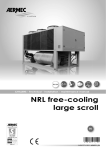
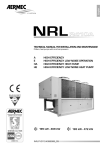
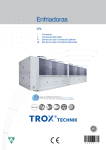
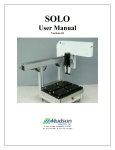
![Troncatrice FESTOOL Kapex KS 120 [pdf 1,89MB]](http://vs1.manualzilla.com/store/data/006136590_1-d5906f7589344a77feb83d1ce6b100a3-150x150.png)

